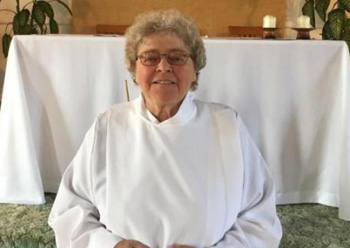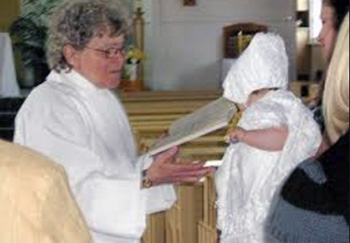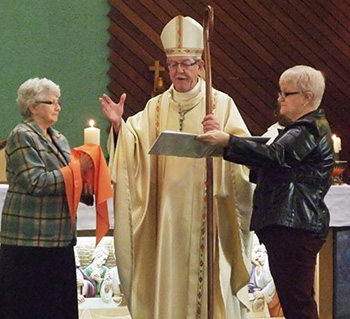VATICAN’S NEW STEP TOWARD ORDAINING WOMEN
Atila Sinke Guimarães
The Congregation for
Divine Worship authorized a religious woman to celebrate a marriage.
Indeed, on July 20, 2017, Sister Pierrette Thiffault from the village
Lorainville in the region of Québec, Canada, replaced the priest and
united Cindy and David in marriage in that parish church. 
Sister Thiffault poses after setting the precedent; below, since 1984 she has been performing baptisms

According to the press, Bishop Dorylas Moreau of Rouyn-Noranda called Sr. Thiffault and asked her to celebrate that marriage. At first she refused, arguing she had no orders and that she could not do so without special permission from the Holy See. After due request by the Bishop, the authorization came in a letter dated May 23, 2017, from the Congregation for Divine Worship and the Discipline of the Sacraments, whose prefect is Card. Robert Sarah, normally presented by the media as a lion of conservatism.
The celebration of the wedding by Sr. Thiffault raised many reactions in the public, which obliged the Diocese to issue a note by its General Vicar, Gilles Chauvain. The note read: “In the Catholic Church this presidency [of a marriage] is exercised only by a priest, but there can be exceptions, and what happed today is one of them.” (Radio Canada, July 20, 2017)
An exception contemplated in the New Code
When we go to investigate what the 1983 Code of Canon Law says on the topic, we read:
Canon 1112 - § 1: “Where there is lack of priests and deacons, the diocesan Bishop can delegate lay persons to assist at marriages, with the previous favorable vote of the Conference of Bishops and after he has obtained the permission of the Holy See.”
Someone may, then, ask: Did the Canadian Bishops authorize this type of exception? The answer: Yes, they did. On September 16, 1983, the Canadian Episcopal Conference approved a decree allowing for lay people to witness marriages in all Dioceses of Canada. (cf. Canon Law Society of America, New Commentary on the Code of Canon Law, New York, NY: 2000, p. 1332)
Analyzing this canon, commentators can securely affirm that, once the Bishops’ Conference issues permission and the Bishop requests and receives approval of the Holy See, he can choose any lay person he deems appropriate, man or woman, in order to witness the marriage in the name of the Church.
The tasks this person can undertake may be even more extended than those reported by the press in the case of Sr. Thiffault. For the reader to evaluate them, I transcribe here the comments of the Canon Law Society of America on canon 1112:
“Care should be exercised in selecting lay people to assist at marriages. They should possess both the personal qualities that make them suitable for this task and the ability to provide appropriate pre-marital instruction to couples and to perform the liturgical rites fittingly. At the wedding itself, the lay delegate presides at the liturgy of the word during which he or she may preach and ask for and receive the spouses’ consent.” (ibid.)

Bishop Dorylas Moreau encourages
women ministers at his Masses
Let me remind my reader that the Code of Canon Law of 1917 only allowed Bishops and priests to celebrate marriages (cf. can 1094-1096).
It was the Code of Canon Law of 1983 that opened the door for the exception we see being put into practice today in Canada.
Therefore, I advise those who blame Bishop Moreau of Rouyn-Noranda or Card. Sarah of the Congregation of the Divine Worship for what took place in Canada to dig a bit deeper in their analysis. The exception of having a woman celebrating a marriage was present in the actual text of canon 1112 of the New Code, which was initiated by Paul VI and sanctioned and promulgated by John Paul II in 1983.
What raised the indignation of many who read about Sr. Thiffault officiating at a marriage were the new principles that oriented the New Code of Canon Law, which are none other than the progressivist principles that inspired Vatican II.
Opening doors for deaconesses
The case of Sr. Thiffault is, nonetheless, very important because it is a first precedent, officially permitted by the Holy See, allowing a woman to replace the priest in his ministerial role of effecting the Sacrament of marriage. Besides being able to administer Baptism, being a Eucharist minister and delivering a sermon, now a woman is also authorized to witness the Sacrament of marriage.
This case of Sr. Thiffault seems to have been sanctioned to take another step toward the ordination of women as deacons, a question that was re-opened more than one year ago when Francis established a commission to study this possibility.
The words of Sr. Thiffault travel in the same direction. Commenting to the press about the precedent she set in administering the Sacrament of marriage, she said: “This a great service rendered to the Church and to me. It represents an openness toward women in our milieu and also in the Diocese.”
She was right. It is a gigantic step toward introducing women deacons and, then, women priests.
